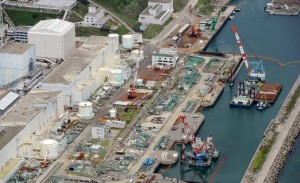Toxic Groundwater Reaching Sea: NRA
ENERGY, 29 Jul 2013
The Japan Times – TRANSCEND Media Service
Watchdog says pit may not be only source of radioactive spike.

Water woes: The Nuclear Regulation Authority said on Wednesday [10 Jul 2013] it strongly suspects highly radioactive water at the Fukushima No. 1 nuclear plant is seeping into the ground and contaminating the Pacific Ocean. | KYODO
Tokyo Electric Power Co. claims it believes the source of contamination to be a pit from which highly radioactive water was found seeping into the sea in April 2011, shortly after the nuclear crisis erupted at the plant. However, the NRA said Tepco’s explanation was questionable and noted that toxic water in the area may not be the only source.
The NRA also urged Tepco to speed up completion of a deeply sunken coastal containment wall between the plant and the Pacific to keep the increasingly highly radioactive groundwater from reaching the ocean.
Tepco should try to finish the wall earlier than the planned March 2015 completion date and should attempt to remove contaminated water collecting in trenches at the plant, the NRA said in a statement Wednesday.
According to Tepco, the level of radioactive cesium in groundwater collected Tuesday from an observation well near the sea soared over 100 times higher than the level taken Friday.
Tuesday’s sample contained 11,000 becquerels of cesium-134 per liter and 22,000 becquerels of cesium-137 per liter.
The nation’s nuclear safety guidelines require cesium-137 levels for waste liquids at nuclear plants to remain below 90 becquerels per liter.
The water also contained 900,000 becquerels of other radioactive substances that emit beta rays, including strontium.
The cesium-137 levels had risen from 18,000 becquerels per liter a day earlier, while those of cesium-134 increased to 11,000 becquerels from 9,000, Tepco said. Safety guidelines require cesium-134 levels at plants to remain below 60 becquerels per liter. The nation’s safety limit for radioactive materials in drinking water is 10 becquerels per liter.
A separate monitoring well at the turbine complex showed cesium-137 levels stable at 0.74 becquerels per liter between July 8 and 9, while cesium-134 rose slightly to 0.50 becquerels from 0.49 becquerels.
Tepco didn’t provide a reason for the spike in radiation levels or explain why levels varied so much at different monitoring wells.
The higher radioactivity levels were found in a well Tepco began surveying Sunday as part of its probes into strontium and tritium found in groundwater at the plant.
Tepco has taken measures to enclose the contaminated seawater in areas near the plant, but cannot completely prevent the spread of every radioactive material into the wider ocean, an NRA official said.
The utility has claimed it has detected “no significant impact” on the environment.
Tepco chief Naomi Hirose said last week the utility would seek permission to restart two reactors at its Kashiwazaki-Kariwa nuclear complex in Niigata Prefecture as soon as possible. The firm, which logged a ¥685.3 billion loss last fiscal year, said in May 2012 that it would return to profit this year if reactors at the plant are restarted.
Go to Original – japantimes.co.jp
DISCLAIMER: The statements, views and opinions expressed in pieces republished here are solely those of the authors and do not necessarily represent those of TMS. In accordance with title 17 U.S.C. section 107, this material is distributed without profit to those who have expressed a prior interest in receiving the included information for research and educational purposes. TMS has no affiliation whatsoever with the originator of this article nor is TMS endorsed or sponsored by the originator. “GO TO ORIGINAL” links are provided as a convenience to our readers and allow for verification of authenticity. However, as originating pages are often updated by their originating host sites, the versions posted may not match the versions our readers view when clicking the “GO TO ORIGINAL” links. This site contains copyrighted material the use of which has not always been specifically authorized by the copyright owner. We are making such material available in our efforts to advance understanding of environmental, political, human rights, economic, democracy, scientific, and social justice issues, etc. We believe this constitutes a ‘fair use’ of any such copyrighted material as provided for in section 107 of the US Copyright Law. In accordance with Title 17 U.S.C. Section 107, the material on this site is distributed without profit to those who have expressed a prior interest in receiving the included information for research and educational purposes. For more information go to: http://www.law.cornell.edu/uscode/17/107.shtml. If you wish to use copyrighted material from this site for purposes of your own that go beyond ‘fair use’, you must obtain permission from the copyright owner.